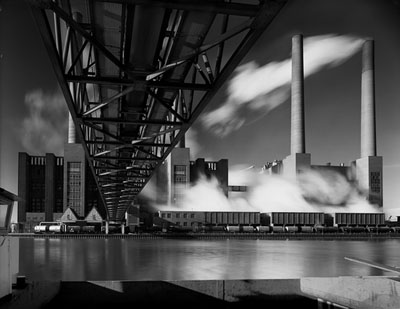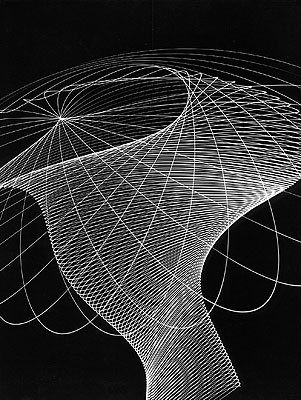Ага.
Вот, в свежей выставке попалось хорошее слово…
Rückkehr zum Aufbruch
Heinrich Heidersberger
Kunstmuseum Wolfsburg
D. Wolfsburg, 26 Apr-21 Sep 2008

Kraftwerk, Wolfsburg 1971
Schwarzweiß-Fotografie
4148/5
Foto: Heinrich Heidersberger
© artur/Institut Heidersberger
Наряду с классикой такого рода, еще и
Rhythmogramm

Rhythmogramm, 1950er/1960er
Schwarzweiß-Fotografie
3782/34
Foto: Heinrich Heidersberger
© Institut Heidersberger
Возможно, этот снимок имеет отношение к этим самым ритмограммам, см. текст ниже.

# 9179 / 1 Selbstportrait, Wolfsburg 1962
Вот тут можно посмотреть:
Heinrich Heidersberger
http://en.heidersberger.de/scripts/fron ... KT&ID=2292
Длинно пишут:
As Heinrich Heidersberger decided to pursue the art of photography in Paris at the end of the 1920s - more by accident and as a result of his insatiable curiosity than anything else - photographers were still known as lensmen, a name that really seems to fit for Heidersberger. At the same time as he did contract work for well-known architects of the Braunschweig School, who appreciated his use of light and the lens in particular, Heidersberger also began to experiment with luminography - the recording of a source of light in motion - at the beginning of the 1950s. He was fascinated by the idea of letting light itself become the object.
The invitation in 1955 to create a mural for the newly constructed School of Engineering in Wolfenbüttel was a welcome occasion for Heidersberger to become more involved with luminography. He began to build a device that he could use to record traces of light directly on photo material. The artist named the pictures he created rhythmograms and continued to pursue his experiments with great enthusiasm. The name he chose was the first indication of the uniqueness of his results.
The rhythmograph, as Heidersberger called his device, was redesigned several times and perfected. The larger version, which was made of a conventional scaffolding, still stands fully functional in the exhibition room of the Heidersberger Institute today and takes up close to twenty square meters of floor space. Using four harmonically muffled pendulums, it creates traces of light on photographic material via a mechanically linked mirror and a point source of light. Three-dimensional images are produced by controlling the frequency, phase difference, amplitude and transmission of the pendulums - two drive the mirror vertically and two horizontally.
Different to the constructive work of his contemporaries, who were following similar ambitions, Heidersberger's light images have a three-dimensional aspect and also include coincidence as a principle in their design. Heidersberger found the inspiration for the multi-dimensional solution in reading a book on "Physics in Graphical Pictures". There he discovered the figures of the physicist Jules Antoine Lissajous and they challenged him to get similar results in photography. From that time on, he called these pictures rhythmograms.
With each structural alteration, the machine became more complex and its use more skilled and more effortless at the same time. By extinguishing the light for a short period of time, for example, Heidersberger discovered new traces and he also began to work on the negatives. As a result of inversion, multiple exposures and sectioning that led to extensive compositions and solarizations, he created a completely new picture language.
His 'machine', as he likes to call it, was paramount to the synthesis of his artistic and scientific interests and still commands an imposing presence in the Wolfsburg Castle today.
In addition to the personal interests described here, the rhythomgrams must also be viewed in their contemporary context. They were very topical at the time of their creation. If we call to mind Applied Art - exemplified by wire and wicker furniture - in the decades after the war or the graphics at that time, the parallels are striking - Heidersberger had his finger on the pulse of the age.
From 1956 to 1968, for example, a rhythmogram was used as the broadcasting symbol of the Südwestfunk Baden-Baden, a regional German television station, and some say that the old national evening news logo was produced by him, a rumor that has not been substantiated to date. In addition, one of Heidersberger's light images received the silver medal at the 11th Triennale di Milano, a very important international exhibition of applied art and architecture at that time.
Contemporaries perceived the works as an adequate expression of modern living conditions: "[a rhythmogram] is able to put space-time relationships into a picture chronographically, lending a temporal process to the elements of space and quantity to produce a great metaphor of our newly won physical view of the world, in which space and time merge to form a uniform continuum at the speed of light." Such comments as this made by Lufft breathe the spirit of the 20th century and underscore once again the fact that Heidersberger is a representative of the modern arts.
Heidersberger also received recognition from artistic circles for his topicality. Jean Cocteau, for example, was so impressed by the relevance of his work that he wrote: (Cocteau quote). It was very early on that the Frenchman bought a rhythmogram as a birthday present for Picasso.
A total of 75,000 negatives are now stored at the Heidersberger Institute and that figure alone lets us imagine what range the rhythmograms cover. With them, Heidersberger created not only a new type of painting with light, but at the same time his mural at the School of Engineering in Wolfenbüttel made him the leader in the field of art on buildings, which first developed into a solid, cultural-political constant in the 1970s. Such utilization of photographic means is still a rarity in comparable contracts.
|










